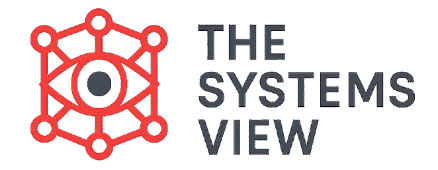There are many ways of looking at systems thinking. It offers not only a set of tools, but also a framework for looking at issues as systemic wholes. For some people, it can even become a way of life! Systems thinking is a language, too, that offers a way to communicate about dynamic complexities and interdependencies. Most Western languages are linear — their basic sentence construction, noun-verb-noun, encourages a worldview of “x causes y.” Because of this, we tend to focus on linear causal relationships rather than circular or mutually causative ones. Yet many of the most vexing problems confronting managers and corporations today are caused by a web of interconnected, circular relationships. To enhance our understanding and communication of such problems, we need a language and a set of tools better suited to the task. This is where systems thinking comes in.
Systems Thinking is a way of seeing problems as parts of a much larger whole. It’s a powerful approach that helps you look past a single event and see the patterns and connections that are causing the problem to happen again and again. For example, if your family keeps getting into the same argument, Systems Thinking would ask you to look at the patterns of communication that are causing it. In a business, if a company is losing customers, a Systems Thinker would look at more than just the product. They might look at the quality of customer service, the delivery process, or how the company’s marketing messages are being received. This way of thinking helps you find the root cause of a problem and make a change that actually lasts.
The Five Core Principles of Systems Thinking
In a simple sense, Systems Thinking means looking at the big picture. But in practice, it means applying five core principles to every problem you face.
1. See the Big Picture
When you are under stress, your natural reaction is to focus on the problem directly in front of you. But a Systems Thinker asks you to step back and look at the wider setting. The cause of today’s pain often sits somewhere else in the system. For example, a service team’s backlog might seem like a problem with the technicians, but the real cause could be a sales incentive that promised too many free installations.
2. Balance Short-Term and Long-Term Views
Quick wins can feel great, but they can quietly harm future results. The goal of Systems Thinking is not to only focus on the long term. It is to look at both the short-term and long-term effects of a decision and to think through the results over time. For example, a company might start by hiring outside experts for a quick fix, then later hire and train its own people. This makes today’s fix a solid foundation for tomorrow’s success.
3. Expect Dynamics, Complexity, and Interdependence
Real life is moving, messy, and connected. Traditional, linear thinking often tries to simplify a problem to a single cause and effect. But this way of thinking has its limits and can create new problems. Systems Thinking asks you to expect and accept that things are complex. It reminds you to keep an eye on the relationships between the parts of a system and between the system and its surroundings.
4. Use Both Numbers and Stories
Good decisions are not made with numbers alone. They are a mix of what you can measure (sales, costs) and what is harder to measure (employee morale, customer attitudes). Only measuring what is easy can blind you to brewing trouble. Chasing only the numbers can hide conflicts and culture issues. Systems Thinking teaches you to use both lenses.
5. You Are Part of the System
This is often the hardest principle to accept. We often help create the very problems we face. We do this with yesterday’s quick fixes, today’s wrong assumptions, and our deep beliefs, which we call mental models. Seeing your own role in a problem can be uncomfortable, but it is also powerful. It shows you that you have new choices and a new ability to make a change.
Important: When you see the system, you stop just putting out fires. You start to design better conditions—better processes, healthier incentives, and a more reliable flow of information. That’s how you get results that last.
Systems Thinking as a Special Language
Why do we call it a language? Systems Thinking gives you a special way to talk about complex problems.
- It uses circular relationships instead of one-way lines. This shows that every action is also a reaction.
- It uses clear rules to reduce confusion and make it easier to communicate.
- It uses visual tools like diagrams and graphs. These visuals help everyone understand the problem without having to be defensive.
- It makes mental models visible. This helps teams compare how they each see the system and find a common understanding.
All of these things make hard conversations about complex issues much more productive.
Two Simple Tools for Systems Thinking
To start speaking the language of Systems Thinking, you can use these two simple tools.
Behavior Over Time (BOT) Graphs
A BOT graph is a simple chart where you sketch a few key variables to see how they move together over time. They are very useful for spotting patterns quickly. For example, a doctor might use a BOT graph to track a patient’s temperature and heart rate over a week to look for patterns in their health. By showing trends over a period, a BOT graph helps you see if a problem is getting worse or better and if it is happening quickly or slowly.
Causal Loop Diagrams (CLDs)
A CLD is a diagram where you draw cause-and-effect loops to show how different parts of a system are connected. You use arrows to show how one variable affects another and use a plus or minus sign to show the type of relationship. For example, a plus sign shows that as “sales” increase, “revenue” also increases. A minus sign shows that as “customer complaints” increase, “customer satisfaction” decreases. They are used to reveal the reinforcing and balancing feedback loops that are at work.
These visuals are a key part of the “language” that makes complex dynamics easier to discuss and understand.
Conclusion
Systems Thinking is a practical way to solve difficult problems. It asks you to widen your view, weigh both short-term and long-term results, map the relationships in a system, and remember that you are a part of that system. When you use both data and judgment and give your team a shared visual language, you can design solutions that last—not just temporary fixes that make the problem worse.



